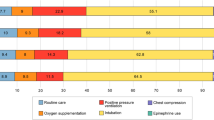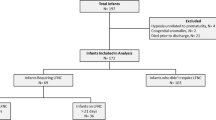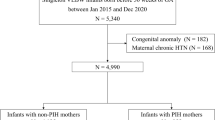Abstract
Background
To compare the outcomes of premature infants stabilized in the delivery room using either the T-piece resuscitator (TPR) or flow-inflating bag (FIB).
Design/methods
Data from five participating level III NICUs within the Canadian Neonatal Network were reviewed. Infants born between 24+0 and 29+6 weeks’ gestational age (GA) from January 1, 2018, to December 31, 2022, receiving mask ventilation in the delivery room were included. Infants who were outborn or had major congenital abnormalities were excluded. The primary composite outcome was death or bronchopulmonary dysplasia (BPD) or severe neurologic injury (intraventricular hemorrhage grade III–IV or periventricular leukomalacia). Logistic regression models adjusted for potential confounders were used to estimate odds ratios with 95% CI for the association with exposure.
Results
Of the 2007 infants admitted to participating sites, 426 were excluded, leaving 1581 who met the inclusion criteria. The primary outcome occurred in 367/745 (49%) infants with the FIB and in 438/836 (52%) infants with the TPR (adjusted OR = 0.87; 95% CI 0.44 to 1.71). There was no association between TPR or FIB with the individual components of the composite outcome (death, BPD, and severe neurological injury).
Conclusions
There were no significant differences in the outcomes of preterm infants stabilized in the delivery room with TPR compared to FIB.
Impact
-
No significant difference in the composite outcome (death, bronchopulmonary dysplasia (BPD), and severe neurological injury) between a flow-inflating bag (FIB) or a T-piece resuscitator (TPR) for respiratory support at birth.
-
Large real-world analyses comparing TPR and FIB in clinical settings.
-
Respiratory support with either device resulted in no statistically different key clinical outcomes.
-
There was no impact on mechanical ventilation or major morbidities with either device.
-
This emphasizes the importance of provider experience and consistent device use over the choice of resuscitation device.
This is a preview of subscription content, access via your institution
Access options
Subscribe to this journal
Receive 14 print issues and online access
$259.00 per year
only $18.50 per issue
Buy this article
- Purchase on SpringerLink
- Instant access to full article PDF
Prices may be subject to local taxes which are calculated during checkout

Similar content being viewed by others
References
Hooper, S. B., Pas, A. B., te & Kitchen, M. J. Respiratory transition in the newborn: a three-phase process. Arch. Dis. Child Fetal Neonatal Ed. 101, F266 (2016).
Aziz, K., Chadwick, M., Baker, M. & Andrews, W. Ante- and intra-partum factors that predict increased need for neonatal resuscitation. Resuscitation 79, 444–452 (2008).
Schmölzer, G. M., Pas, A. B., te Davis, P. G. & Morley, C. J. Reducing lung injury during neonatal resuscitation of preterm infants. J. Pediatr. 153, 741–745 (2008).
Aziz, K. et al. Part 5: neonatal resuscitation: 2020 American Heart Association Guidelines for Cardiopulmonary Resuscitation and Emergency Cardiovascular Care. Circulation 142, S524–S550 (2020).
Wyckoff, M. H. et al. Neonatal life support: 2020 international consensus on cardiopulmonary resuscitation and emergency cardiovascular care science with treatment recommendations. Circulation 142, S185–S221 (2020).
Trevisanuto, D. et al. Devices for administering ventilation at birth: a systematic review. Pediatrics 148, e2021050174 (2021).
Dawson, J. A. et al. Oxygenation with T-piece versus self-inflating bag for ventilation of extremely preterm infants at birth: a randomized controlled trial. J. Pediatr. 158, 912–918.e2 (2011).
Szyld, E. G. et al. Comparison of devices for newborn ventilation in the delivery room. J. Pediatr. 165, 234–239.e3 (2014).
Thakur, A. et al. T-piece or self inflating bag for positive pressure ventilation during delivery room resuscitation: An RCT. Resuscitation 90, 21–24 (2015).
Guinsburg, R. et al. T-piece versus self-inflating bag ventilation in preterm neonates at birth. Arch. Dis. Child Fetal Neonatal Ed. 103, F49 (2018).
Roehr, C. C. et al. T-piece resuscitator or self-inflating bag during neonatal resuscitation: a scoping review. Pediatr. Res 89, 760–766 (2021).
Tribolet, S., Hennuy, N. & Rigo, V. Ventilation devices for neonatal resuscitation at birth: A systematic review and meta-analysis. Resuscitation 183, 109681 (2023).
Shah, V., Hodgson, K., Seshia, M., Dunn, M. & Schmölzer, G. M. Golden hour management practices for infants <32 weeks gestational age in Canada. Paediatr. Child Heal 23, e70–e76 (2018).
Bowman, T. A., Paget-Brown, A., Carroll, J., Gurka, M. J. & Kattwinkel, J. Sensing and responding to compliance changes during manual ventilation using a lung model: can we teach healthcare providers to improve?. J. Pediatr. 160, 372–376.e1 (2012).
Kattwinkel, J., Stewart, C., Walsh, B., Gurka, M. & Paget-Brown, A. Responding to compliance changes in a lung model during manual ventilation: perhaps volume, rather than pressure, should be displayed. Pediatrics 123, e465–e470 (2009).
Dawson, J. A., Gerber, A., Kamlin, C. O. F., Davis, P. G. & Morley, C. J. Providing PEEP during neonatal resuscitation: Which device is best?. J. Paediatr. Child Heal 47, 698–703 (2011).
Gibbs R. N., Ramsie M., O’Reilly M., Lee T. F., Schmölzer G. M. Supraglottic airway in neonatal porcine model. Pediatr. Res. 1–6 (2025).
Elm, E. V. et al. The Strengthening the Reporting of Observational Studies in Epidemiology (STROBE) statement: guidelines for reporting observational studies. J. Clin. Epidemiol. 61, 344–349 (2008).
Network C. N. Canadian neonatal network Abstractor’s Manual v3.8 [Internet]. 2025 [cited 2025 Mar 5]. Available from: https://www.canadianneonatalnetwork.org/portal/CNNHome/Publications.aspx
Shah, P. S. et al. Internal Audit of the Canadian Neonatal Network Data Collection System. Am. J. Perinatol. 34, 1241–1249 (2017).
Papile, L. A. et al. Incidence and evolution of subependymal and intraventricular hemorrhage: a study of infants with birth weights less than 1,500 gm. J. Pediatr. 92, 529–534 (1978).
Kwon, S. H., Vasung, L., Ment, L. R. & Huppi, P. S. The role of neuroimaging in predicting neurodevelopmental outcomes of preterm neonates. Clin. Perinatol. 41, 257–283 (2014).
Bell, M. J. et al. Neonatal necrotizing enterocolitis. Therapeutic decisions based upon clinical staging. Ann. Surg. 187, 1–7 (1978).
The International Classification of Retinopathy of Prematurity Revisited International Committee for the Classification of Retinopathy of Prematurity. Arch. Ophthalmol. 123, 991–999 (2005).
Kramer, M. S. et al. A new and improved population-based canadian reference for birth weight for gestational age. Pediatrics 108, e35–e35 (2001).
Ting, J. Y., Synnes, A. R., Lee, S. K., Shah, P. S. & Network on behalf of the CNN and CNFU Association of admission temperature and death or adverse neurodevelopmental outcomes in extremely low-gestational age neonates. J. Perinatol. 38, 844–849 (2018).
Lyu, Y. et al. Association between admission temperature and mortality and major morbidity in preterm infants born at fewer than 33 weeks’ gestation. JAMA Pediatr. 169, e150277–e150277 (2015).
Klingenberg, C. et al. Sustained inflations: comparing three neonatal resuscitation devices. Neonatology 100, 78–84 (2011).
Pas et al. Establishing functional residual capacity at birth: the effect of sustained inflation and positive end-expiratory pressure in a preterm rabbit model. Pediatr. Res. 65, 537–541 (2009).
Wheeler, K. et al. Establishing lung gas volumes at birth: interaction between positive end-expiratory pressures and tidal volumes in preterm rabbits. Pediatr. Res. 73, 734–741 (2013).
Siew, M. L. et al. Positive end-expiratory pressure enhances development of a functional residual capacity in preterm rabbits ventilated from birth. J. Appl. Physiol. 106, 1487–1493 (2009).
Menakaya, J., Andersen, C., Chirla, D., Wolfe, R. & Watkins, A. A randomised comparison of resuscitation with an anaesthetic rebreathing circuit or an infant ventilator in very preterm infants. Arch. Dis. Child Fetal Neonatal Ed. 89, F494 (2004).
Schmölzer, G. M. et al. Non-invasive versus invasive respiratory support in preterm infants at birth: systematic review and meta-analysis. BMJ 347, f5980 (2013).
Debay, A. et al. Association of delivery room and neonatal intensive care unit intubation, and number of tracheal intubation attempts with death or severe neurological injury among preterm infants. Am. J. Perinatol. 39, 776–785 (2020).
Tyson, J., Pedroza, C. & Wootton, S. Analyses of large data bases and pragmatic clinical trials: advancing comparative effectiveness research in a learning health care system. Am. J. Perinatol. 32, 1095–1097 (2015).
Acknowledgements
The authors gratefully acknowledge all site investigators and abstractors of the Canadian Neonatal Network (CNN) including Carlos Fajardo (Alberta Children’s Hospital, Calgary), Jonathan Wong (British Columbia Women’s Hospital, Vancouver), Andrzej Kajetanowicz (Cape Breton Regional Hospital, Sydney), Bruno Piedboeuf and Christine Drolet (Centre Hospitalier Universitaire de Quebec, Sainte Foy), Valerie Bertelle and Edith Masse (Centre Hospitalier Universitaire de Sherbrooke, Fleurimont), Anie Lapointe, Guillaume Ethier, and Keith Barrington (Centre Hospitalier Universitaire Sainte-Justine, Montreal), Brigitte Lemyre (Children’s Hospital of Eastern Ontario, Ottawa), Hala Makary (Dr. Everett Chalmers Hospital, Fredericton), Ayman Abou Mehrem (Foothills Medical Centre, Calgary), Amit Mukerji (Hamilton Health Sciences Centre, Hamilton), Molly Seshia and Deepak Louis (Health Sciences Centre, Winnipeg), Kyong-Soon Lee (Hospital for Sick Children, Toronto), Jehier Afifi (Izzak Walton Killam (IWK) Health Centre, Halifax), Jo-Anna Hudson (Janeway Children’s Health and Rehabilitation Centre, St. Johns), Victoria Bizgu (Jewish General Hospital, Montreal), Faiza Khurshid (Kingston Health Sciences Centre, Kingston), Orlando da Silva (London Health Sciences Centre, London), Marie St-Hilaire (Maisonneuve-Rosemont Hospital, Montreal), Martine Claveau and Marc Beltempo (McGill University Health Centre, Montreal), Jaya Bodani (Regina General Hospital, Regina), Jennifer Toye and Joseph Ting (Royal Alexandra Hospital & University of Alberta Hospital, Edmonton), Miroslav Stavel (Royal Columbian Hospital, New Westminster), Lannae Strueby (Royal University Hospital / Jim Pattison Children’s Hospital, Saskatoon), Cecil Ojah and Alana Newman (Saint John Regional Hospital, St. John), Ruben Alvaro and Ann Yi (St. Boniface General Hospital, Winnipeg), Eugene Ng (Sunnybrook Health Sciences Centre, Toronto), Rebecca Sherlock (Surrey Memorial Hospital, Surrey), Caio Barbosa de Oliveira (The Moncton Hospital, Moncton), Brigitte Lemyre (The Ottawa Hospital, Ottawa), Jaideep Kanungo (Victoria General Hospital, Victoria), Sajit Augustine (Windsor Regional Hospital, Windsor), and Prakesh Shah (Mount Sinai Hospital, Toronto) for their valuable contributions as CNN investigators.
Funding
The project described in this manuscript was conducted with no specific financial support. No honorarium, grant, or other form of payment was given to anyone to produce this manuscript.
Author information
Authors and Affiliations
Consortia
Contributions
Conception and design: G.M.S., M.B., J.T., A.S. Collection and assembly of data: G.M.S., J.T., E.N., A.S., R.A., M.B., J.T., Analysis and interpretation of the data: G.M.S., M.S., J.T., E.N., A.S., R.A., M.B., J.T., Drafting of the 1st draft: M.S., Critical revision of the article for important intellectual content: G.M.S., M.S., J.T., E.N., A.S., R.A., M.B., J.T., Final approval of the article: G.M.S., M.S., J.T., E.N., A.S., R.A., M.B., J.T.
Corresponding author
Ethics declarations
Competing interests
The authors declare no competing interests.
Additional information
Publisher’s note Springer Nature remains neutral with regard to jurisdictional claims in published maps and institutional affiliations.
Supplementary information
Rights and permissions
Springer Nature or its licensor (e.g. a society or other partner) holds exclusive rights to this article under a publishing agreement with the author(s) or other rightsholder(s); author self-archiving of the accepted manuscript version of this article is solely governed by the terms of such publishing agreement and applicable law.
About this article
Cite this article
Shaker, M., Toye, J., Ng, E. et al. Outcomes of preterm infants stabilized with flow-inflating bag or T-piece resuscitator at birth—a Canadian neonatal network cohort study. Pediatr Res (2025). https://doi.org/10.1038/s41390-025-04467-2
Received:
Revised:
Accepted:
Published:
DOI: https://doi.org/10.1038/s41390-025-04467-2



